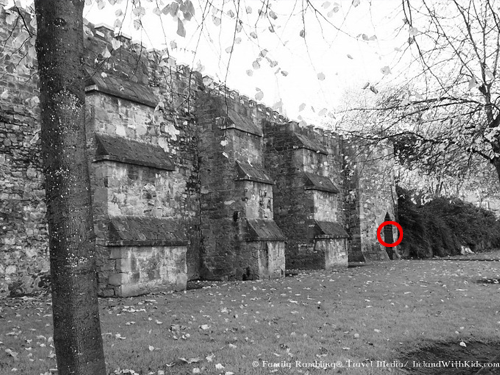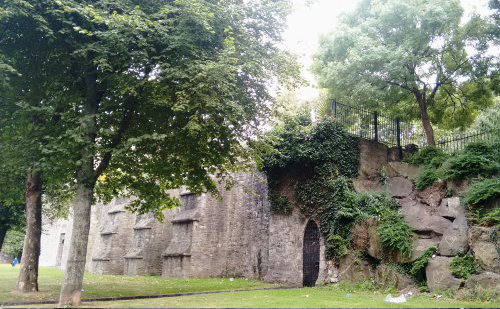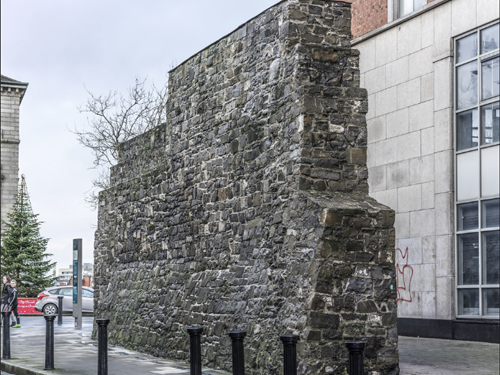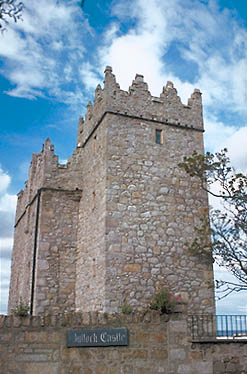There are references to Fagan Castle, Fagan's Castle, Fagan's Gate in the Dublin area, and a Fagan that owned property and possibly a castle in Bullock
Fagan's Castle & Fagan's Gate (Dublin)
There are references to Fagan's Castle in Burke's Peerage & Gentry in reference to Christopher Fagan, Mayor of Dublin (1573), High Sheriff (1565) and his son "Thomas, of Castle Fagan and Palmerston, Co Dublin".
According to Samuel A. Ossory Fitzpatrick in his 1907 work "Dublin: A Historical and Topographical Account of the City": In an area of Palmerstown, near High Street and Cork Street, ..."the most interesting relic of the ancient fortifications is to be found in St. Audoen's Arch, situated at a distance of 51 feet from the northern wall of the church of the same name, and forming part of the inner wall built by the citizens to repel Edward Bruce, and which extended from that gate, north of St. Audoen's churchyard, to a building called Fagan's Castle in Pagee's Court, where there was another portal, and thence to New Gate."
St. Audoen's Park, although less than 0.5 hectares in size, is quite significant in historical terms. Located adjacent to St. Audoen's Church (1300 A.D.), it incorporates the first stone city wall dating from about 1100 A.D.; St. Audoen's Arch, the last surviving entrance to the old city; and Fagan's Gate.
According to a group called Dublin Studies at Dublin's official website, "Fagan's castle and gate were situated in Page's Court, a passage between Cornmarket and Cook Street within the old Dublin City Walls. Fagan's Castle stood there until 1788. They may have been named after the Fagans of Feltrim. Feltrim, near Malahide, was the site of their ancestral residence. Their burial place in the 16th and 17th centuries was at St. Audeon's Church, also within the old city walls.
According to Carte Calendar Volume 44, July-December 1666 at the Bodleian Library, University of Oxford's Department of Special Collections and Western Manuscripts:
Petition of Claudius, Earl of Abercorn to the King
Date: [1666?]
Shelfmark: MS. Carte 60, fol(s). 274
Document type: Original. Endorsed by Ormond.
Recites the advancement by petitioner's father, James, Earl of Abercorn, to the then Lord Treasurer of Scotland, the Earl of Traguhair, of several considerable sums of money for the service of his late Majesty ...
Prays his Majesty's license to proceed in the execution of "an agreement made by him with her Grace the Duchess of Portsmouth, and the Lord Kingston's Commissioners, for such lands as, by ... your petitioner's father's neglect, are left vested in your Majesty"; and also for the grant of a lease of the remainder of the estate of Christopher Fagan of Feltrim ["Feltrim Castle was the seat of the ancient family of Fagan, long proprietors of the surrounding district; it was made nominally the prison, but really the ... home of Gerald 16th Earl of Desmond, - the proprietor, Christopher Fagan, refusing to exchange the character of host for that of 'keeper' " (Daily Gazetteer of Ireland, sub voce). Hither, James II came, after the battle of the Boyne], upon his dying; petitioner being heir-at-law to said Fagan, if he die without heirs-male.
According to the Malahide Historical Society's Illustrated Guide to Historical Malahide - Part II:
"An archaeological dig took place on Feltrim Hill in 1947 and upwards of 500 items of interest were found. These included Roman coins and a tinned bronze mount dating to the 4th. Century A.D. Feltrim Castle was originally a 'Ten Pound Castle', built in 1429. The Fagan family has always been associated with Feltrim and in 1574 Sir Christopher Fagan allowed
Gerald Fitzgerald, Earl of Desmond, to escape even though he had been committed to him as a prisoner on parole.
NOTE: Ten-Pound-Castles were small castles, very similar to tower houses, that were mainly built to take advantage of royal subsidies - king Edward VI in 1429 guaranteed a certain income for anyone building a castle to defend the "pale" (the area of English rule in Ireland).
In 1690, fleeing from the Battle of the Boyne, King James stayed for some time with Richard Fagan of Feltrim. From the 1700's onwards the Fagan family suffered an eclipse and Feltrim Castle was demolished by the mid-eighteenth century. In the environs of the castle, Fagan's Well still stands in a good state of preservation..."
Fagan's Gate Revisited
Bullock Castle:
From "Bullock Through the Ages" (compiled by Alice and Mairead)
Bullock Castle stands on the Dun Laoghaire - Dalkey Road welcoming visitors to this beautiful and historic area. The castle fell into disuse and luckily was left unchanged by it many owners. Now the first phase of restoration has been completed, the new roof keeps out the rain and the repaired stonework has dried out.
The Castle of Bullock, to which a modern house has been attached, forms a conspicuous object on the road from Kingstown to Dalkey. It stands between the road and the sea, and overhangs a creek, now converted into a harbour.
Mr. J. H. Parker, c.b., an eminent authority on Gothic architecture, who inspected the Castle in 1859, formed the opinion that it was a structure of the 12th century. He says that it is built of plain and rude masonry, and that in plan it is a simple oblong. The lower story is vaulted throughout, and the rooms in it, he thought, were probably used as a store-house.
Above the vault the Castle is divided into two unequal portions. In the larger division there are two principal rooms, one over the other, with small, round-headed windows and doorways; each of these rooms is provided with a fireplace, and there is a garderobe in a turret at one corner, and a small closet in another, with a staircase between.
The smaller division of the house is divided into three stories, above the vaults, probably for bedrooms; there are no fireplaces, and the windows are squareheaded. The two ends of the building are higher than the centre, but, in Mr. Parker's opinion, it is all part of one design and was built together; the battlements are in the form of steps.
Under one portion of the Castle there is an archway, probably used to pass from one courtyard to another, and there were, when Mr. Parker made his inspection, remains of a bawn, as well as of a tower, which has since disappeared, but which stood about 100 yards from the Castle on the Dalkey side.
The Fagan "Connection"
From A history of the county Dublin (Google Books):
During the 16th century the Castle and the lands had been assigned by the Taibots to members of one of the great Dublin mercantile families of the day, the Fagans, whose principal residence was Feltrim, near Swords, and whose ancestors had been amongst the earliest English settlers; and we find amongst the members of the family in possession of Bullock, Christopher Fagan and his younger brother, Richard, each of whom filled the high position of Mayor of Dublin.
When the Great Rebellion broke out in October, 1641, the eldest son of Richard Fagan, Mr. John Fagan, was in occupation of the Castle, and, whether from compulsion or inclination, appears (from depositions made afterwards) to have rendered the rebels much assistance. One of the first efforts to reduce to obedience the neighbourhood of Dublin was made at Bullock, and it was the scene of cruel retaliation for the outrages which had been committed.
A month after the rising a party of soldiers, under the command of Colonel Lawrence Crawford, an officer of more courage than judgement, descended on the village, and, finding that the inhabitants on their approach had put to sea, the soldiers pursued them in boats, and threw them-men, women and children, to the number of 56 - overboard.
All through that winter the southern part of the County Dublin remained at the mercy of the rebels. Shortly before Christmas, John Fagan came from Feltrim to his Castle at Bullock and, according to the evidence of his servant, finding no provisions ready for him, went on to Carrickmines Castle, which, belonged to his relatives, the Walshes. It was the headquarters of the rebels, and to it he sent, subsequently, from Bullock supplies of fish and a small cannon, which had been on the battlements.
In the following March Carrickmines Castle was levelled with the ground, and, a few weeks later, another descent was made on Bullock, this time by Colonel Gibson's regiment, and some of the men found there were killed and others brought prisoners to Dublin.
The Castle was then seized by the Crown, and a garrison of soldiers was maintained in it until the Commonwealth was established in Ireland. At first the garrison was in charge of Colonel Crawford, but, on the cessation with the Irish, he joined the army of the Parliament in England, and a Captain Richard Newcomen succeeded him. In Newcomen's time the garrison consisted of seven non-commissioned officers and 60 men, under command of himself, Lieutenant Valentine Wood, and Ensign Arthur Whithead, the weekly charge for the soldiers being £7, and for the officers £1 3s.
In 1644 the defences of the Castle were strengthened by the construction of a rampart, furnished with three cannon, which were conveyed to Bullock by boat under a military escort, and the erection of a guard house. The estimated cost of this work, which appears to have been exceeded, was £25; brick was the material used, and masons, carpenters, carters, and labourers, who were fed from the regimental canteen, were employed.
At the time of the Battle of Rathmines the authorities of the Parliament had friends at Bullock, and the garrison had probably joined their forces. During the Commonwealth Bullock, owing to the anchorage of the warships near it was, like Dunleary, a place of importance, and soldiers, doubtless, were kept in the Castle.
In 1656 Captain Richard Roe, who was buried at Lusk, died there, and, in 1659, Captain Abraham Aldgate, who was reprimanded for giving assistance to Edmund Ludlow, and who pleaded lack of intelligence to understand the marvellous changes of the time, fled thither on horseback from Dublin, and took refuge on his ship.
The inhabitants were not left without religious consolation and, in 1658, the Rev. Nathaniel Hoyle, B.D., a Fellow of Trinity College, and afterwards a prebendary in Emly Diocese, was paid £100 a year by the Parliament for acting as minister of Bullock.
At the time of the Restoration Bullock was stated to be "a fair ancient town of fishing"; its slated Castle and bawn were in good repair, the haven was accounted a safe one, and there was a population of fifteen English and ninety-five Irish, inhabiting some twenty houses.
John Fagan had died shortly after the Rebellion, in 1643, and had been succeeded by his grandson, Christopher Fagan. The latter had been of service to the Royalist Army in the later years of Charles the First's reign, and, on the Restoration, was restored as an innocent Roman Catholic to all the family possessions, including the Castle and lands of Bullock, and the revenue from chief fish, tithe fish, customs, and fish and corn tithe.
The Fagan family, however, did not long remain in possession, as Richard Fagan, who succeeded his father, Christopher Fagan, on his death, in 1683, was, after the Revolution, attainted for treason committed at Swords, and his property all confiscated.
Bullock and its lands were sold by the Crown, and purchased, for £1,750, by Colonel Allen, of Stillorgan, afterwards the first Viscount Allen, whose representative, the Earl of Carysfort, is now the owner of the soil.
The Rectory and tithes were at the same time given to augment the vicarages of Kill-of-the-Grange and Stillorgan, then under the charge of the curate of Monkstown, and possessing no church of their own.
So far back as the time of Charles I. there had been a revenue officer at Bullock, and, after the Restoration, one Jenkin Hopkins applied for that position. In the beginning of the 18th century the office was no sinecure and, in addition to his duties with regard to the revenue, the officer had to watch the illegal exportation of recruits for the French service.
A detachment of soldiers was, in 1731, sent to Bullock, to prevent the embarkation of men thus enlisted, and only arrived in time to find that "the wild geese," to the number of 40, had flown the preceding night, in company with some French officers.
The prevention of smuggling led often to serious rioting and, in 1735, a great battle took place at Bullock, in consequence of the seizure of a quantity of brandy and tea, and one of the revenue officers was wounded and two of the smugglers killed. In 1743 a Mr. Anthony Robinson filled the position of riding officer at Bullock, and displayed much activity in seizing whiskey concealed in churns, as well as chocolate, seal skins, and tortoise shell, which were being brought from Galway to Dublin.
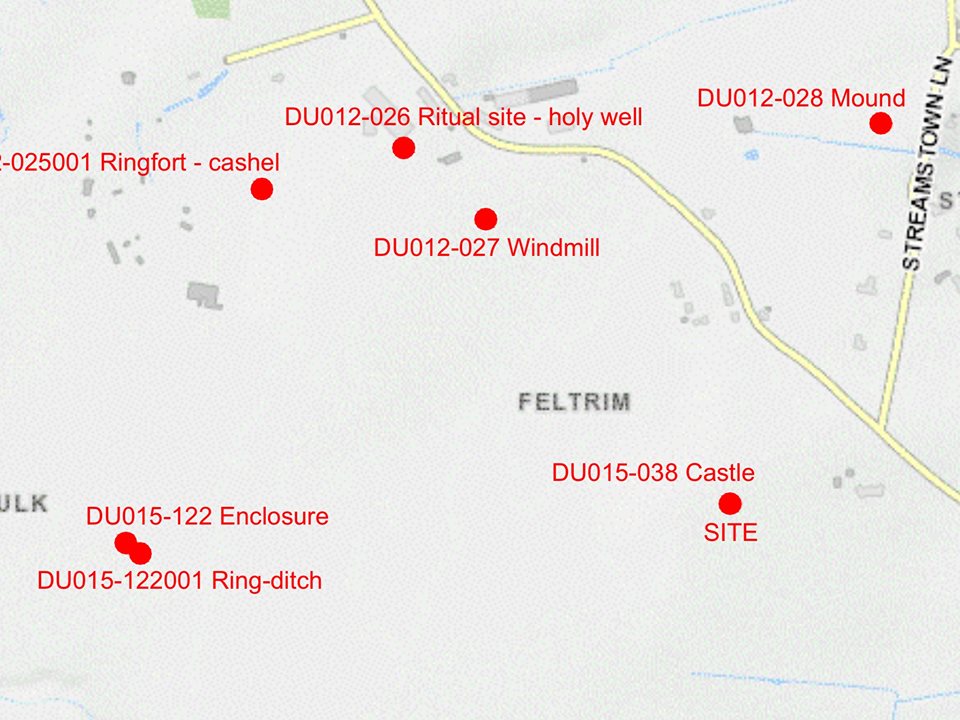 In 1429, King Henry VI of England granted £10 to any of his subjects who succeeded in building a 40-foot-high defensive tower by 1439 to help defend the part of Ireland under his rule known as The Pale. "Fagan’s Castle" in Feltrim Hill, North County Dublin, was one of these Ten Pound Castles. Maps from the sixteenth century further document that Fagan House was a prominent estate in Feltrim. Among its more celebrated residents were Christopher Fagan, Lord Mayor of Dublin, and his brother Richard, Sheriff of Dublin during the reign of Elizabeth I. Remains of Fagan House and Castle’s basement and possibly one of its original oak trees still remain.
In 1429, King Henry VI of England granted £10 to any of his subjects who succeeded in building a 40-foot-high defensive tower by 1439 to help defend the part of Ireland under his rule known as The Pale. "Fagan’s Castle" in Feltrim Hill, North County Dublin, was one of these Ten Pound Castles. Maps from the sixteenth century further document that Fagan House was a prominent estate in Feltrim. Among its more celebrated residents were Christopher Fagan, Lord Mayor of Dublin, and his brother Richard, Sheriff of Dublin during the reign of Elizabeth I. Remains of Fagan House and Castle’s basement and possibly one of its original oak trees still remain.








 In January of 2012, I contacted the folks who take care of Saint Audoen's Park in Dublin. We had a very informative exchange if information about Fagan's Gate & Fagan's Tower (see Fagan's Tower).
In January of 2012, I contacted the folks who take care of Saint Audoen's Park in Dublin. We had a very informative exchange if information about Fagan's Gate & Fagan's Tower (see Fagan's Tower).

